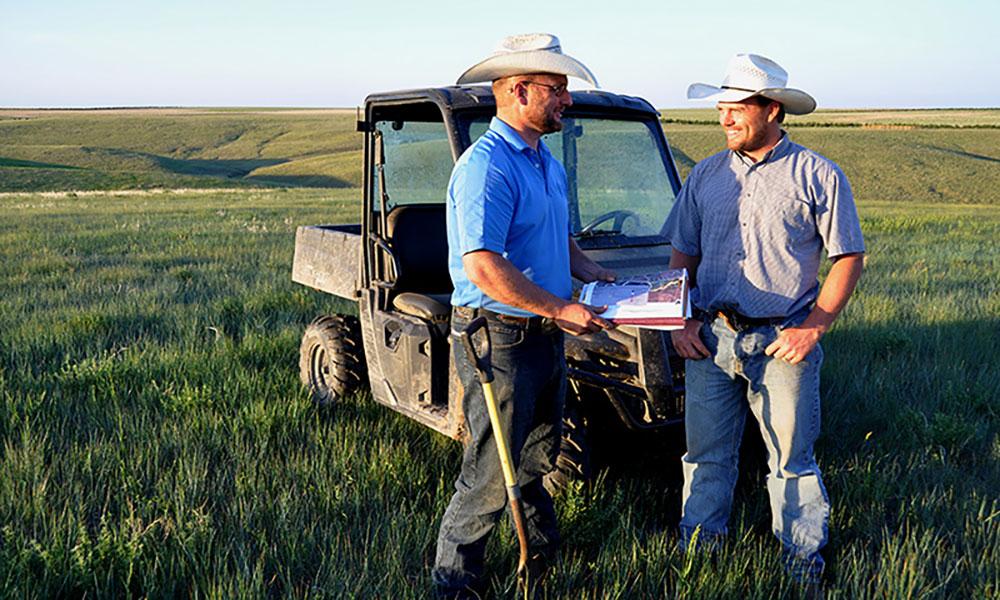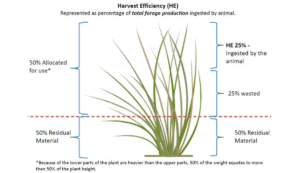Now that I’ve dated myself to some of you, one thing most of us have in common is the principle of saving. You put money in a savings account in a bank or an IRA or 401k account—with the promise that once you have enough money saved, you’ll meet a long-term goal. Buy more cows? Take a vacation with your wife? (Yes, five years after your wedding is no longer a honeymoon!). Add a new corral system that better suits how you work cattle? Saving money is tangible. You can see the dollar amount in your savings account increase month-after-month. It gives you a sense of relief, right? Pride, even, that you’re making progress!
But you also have another bank account—the one full of grass out on your land. It just might be one of the most important accounts you have. I have some science degrees (a strong relative to math), and I’m here to tell you that, while there are scientific principles that guide grazing management and ecological interactions, grazing itself is also an art—one that has a bit of math to it! One way to perfect that art is by understanding how much: 1) You want to leave in your ‘grass account’, 2) How much you can take from your account, 3) How long you can leave your account ‘open’ and when you need to ‘close it’ for the year and 4) How many animals you can support without irritating the (grass) bank.
(This is where you call your mom or reiterate to your kids that, indeed, math is important!)
Math Example
Let’s walk through an example to put the math into perspective:
- You know the following:
- Number of acres in the pasture
- Forage production (in pounds per acre)**
- Number of animals and their associated class (pairs, stockers, bulls)
- Average weight of the animals
- You want to know:
- How many grazing days that pasture can support
STEP 1. CALCULATE ‘TOTAL FORAGE PRODUCTION.’
- 400 acres × 2,000 pounds production per acre** = 800,000 pounds total forage
**The average forage production per acre can be obtained through several methods. The USDA NRCS Web Soil Survey website is a great start, or you can use a “clip and weigh” method, or a Grazing Stick. Your local NRCS service center or SDSU Extension office can get you started with any of these methods.
STEP 2. CALCULATE ‘FORAGE ALLOCATED FOR CONSUMPTION.’
- This is where “take half, leave half” comes in. You want to leave half of that total forage behind. This is for several reasons. Leaving approximately 50% behind means that in a normal year, there’s enough leaf structure and root growth to allow for adequate regrowth of your bank account next year. Although we leave behind 50%, your cow will not consume the entire other 50%, instead it is utilized. This means that 25% of that will end up in the cow’s stomach and the other 25% is beneficially “used” through trampling, manure coverage or insects. Figure 1 demonstrates this concept.
- Now, because you are leaving half behind (50%) + about 25% is beneficially used = 75%, leaving us 25% to put into our cattle. This 25% is known as the grazing efficiency.
- The math becomes 800,000 × 0.25 (25% grazing efficiency) = 200,000 pounds allocated for consumption across that 400-acre pasture.
STEP 3. CALCULATE ‘FORAGE DEMAND.’
- This is where you must know your pastures and the state of production your animals are at. A general rule of thumb is that a lactating cow with a calf at her side requires close to 3% of her body weight (2.7% to be specific) based on dry matter intake.
- Forage quality, though, adjusts the amount a cow will consume. For example, high quality forage (> 59% TDN) equates to high digestibility, meaning that the cow will intake about 2.7% of her body weight if she is lactating. In contrast, low quality forage (< 52% TDN) equates to low digestibility and that same lactating cow will consume about 2.2% of her body weight.
- Table 1 outlines the forage demand on a dry matter intake (DMI) basis and is presented as a percent of body weight (BW) (Hibbard and Thrift 1992, Lalman 2004).
- For this example, we are going to use the 2.7% and assume that we have high quality forage.
- Our cows weigh approximately 1,300 lbs and we own 200 head. 1,300 lb × 0.027 (2.7% body weight consumed) = 35.1 pounds. Each pair we have requires 35.1 pounds of forage per day.
- But wait! As you are reading this, it is a bit into the fall (August/September), so the calves are grazing some on their own and mom is still lactating. The majority of the calf’s nutrition comes from grass now. Thus, we should account for what the calf will be eating. If our calves are approximately 450 pounds, then 450 pounds × 0.027 (2.7% body weight consumed) = 12.2 pounds forage required per calf per day. This means that about 3 calves will eat as much as 1 cow per day at this time of year!
- So, the intake per pair (again, if we adjust our calculation for this time of year) = 35.1 pounds (cow) + 12.2 pounds (calf) = 47.3 pounds.
- Now, we calculate the forage demand for the entire herd per day. We own 200 pairs = 200 × 47.3 pounds per day = 9,460 pounds of forage is needed to feed the entire herd for one day!
- If we only accounted for the cows, and not the calves, the forage demand for the entire herd would equal 7,020 lbs for one day. This is a difference of about 2,400 pounds per day!
| Forage Type and Maturity | ||
|---|---|---|
| Low quality forage (< 52% TDN)
Examples: Dry winter forage, mature legume and grass hay, straw |
||
| Medium quality forage (52-59% TDN)
Examples: Dry summer/fall pasture, late-bloom legume hay, early-bloom grass hay |
||
| High quality forage (> 59% TDN)
Examples: Early-bloom and mid-bloom legume hay, pre-boot stage grass hay, lush pasture, silage |
STEP 4. CALCULATE ‘GRAZING DAYS’ IN THIS PASTURE.
- To calculate the grazing days we have in one pasture, we take the forage allocated divided by the forage demand per day to arrive at the number of grazing days.
- 200,000 pounds allocated divided by 9,460 pounds forage per day = 21 days of grazing can occur in this pasture.
- Again, if we only accounted for the cows, then 200,000 pounds allocated divided by 7,020 pounds forage per day = 28 days of grazing. That’s an entire week of difference! If you only calculated for what the cows are eating and not the calves, you would have kept them in for 7 days longer, which might not sound like a lot, but it is something that can make a difference in a year that is droughty in some parts of South Dakota, the Midwest and Western states.
- Simply put, 21 days of grazing can occur in that pasture, feeding your entire herd, and keeping the land managed in a way that soil and rangeland health are protected.
STEP 5. RECORD IT AND KEEP TRACK!
- Do you ever try to go to the grocery store without a list written down? How often do you get home and realize that you forgot the milk? I know this happens to me quite a bit! That’s why a written record is the best record! Be sure that you are writing down your calculations (so you remember how you did the math and can double check for mistakes) and so that you can see any patterns or changes in your stocking rate that have occurred over time.
In Summary
It might seem a bit silly to check in on your stocking rate calculations, but it is something that is undoubtedly worth your time whether you’re a seasoned rancher or you’re still trying to get your feet under you. Calculating these as we approach fall and early winter are worthwhile, so that you have an idea of what you should be looking at for spring turnout and beyond. A new grazing season will be here before we know it!
Sources:
- Hibbard, C.A. and T.A. Thrift. (1992). Supplementation of forage-based diets: are results predictable? J. Anim. Sci. 70 (Suppl. 1):181. (Abstr.)
- Lalman, D. (2004). Nutrient requirements of beef cattle. Oklahoma Coop. Ext. Serv. E913.
Photo Courtesy: USDA NRCS









